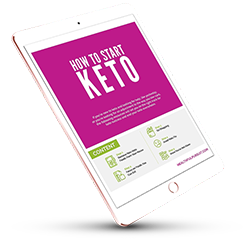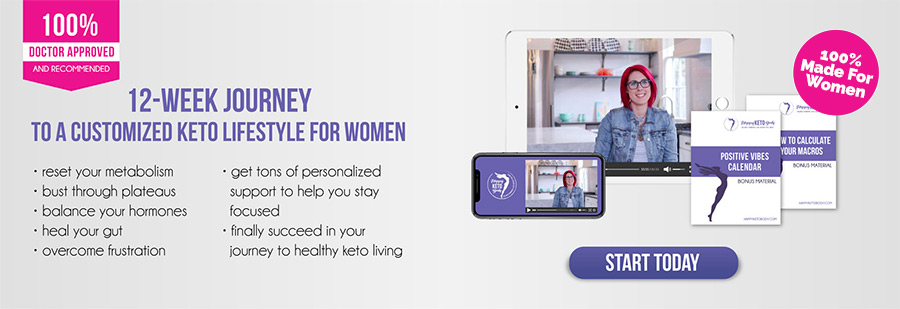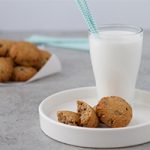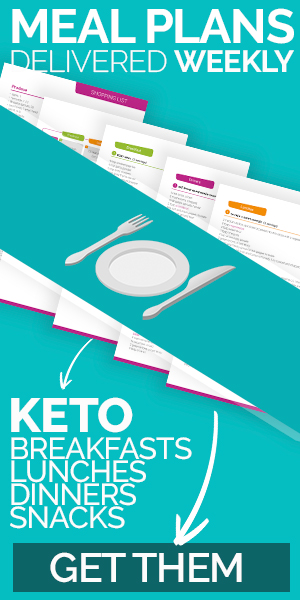I want...
Mistakes Women Make On Keto & Overcoming Keto Flu
September 15, 2018 By
Leanne Vogel

 October 12, 2018
October 12, 2018
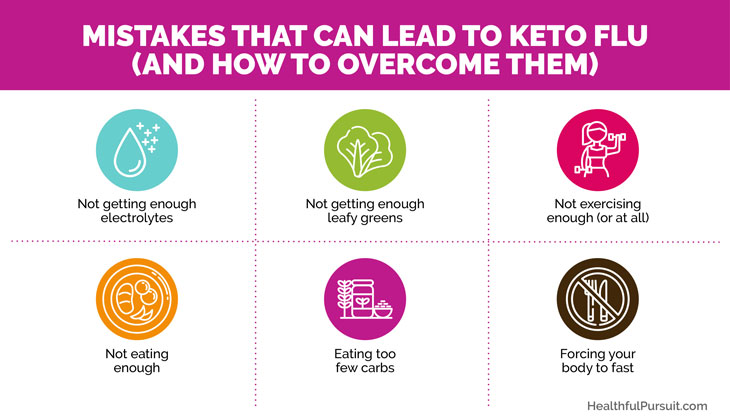
Are you experiencing side effects on your keto diet? What keto women do wrong, and how to adjust your low-carb approach to avoid keto flu and other keto frustrations.
If you searched something like, weight loss for women and magically landed on this page you may be asking yourself, ‘What is keto?”. It helps to know the basics so that you can follow along in this conversation! Keto is a metabolic state that, once you’re in the state, allows you to burn fat as your primary fuel. If you do not eat a keto diet, or know what keto is, then you’re likely glucose fueled. All this means is that you are using glucose, or carbohydrates, to give you energy. With the keto diet, we are using fat – the fat on our bodies or the fat in the food we eat, to fuel us.
Keto shopping lists, recipes, and more! Start keto with this FREE 5-step guide.
I'm ready!For the most part, it’s rare to experience any extreme side effects while on a low-carb diet like the ketogenic diet. However, knowing exactly how this type of diet impacts the body is important to those who are planning to go keto, as it will help you understand and prevent any potential side effects that may crop up. Read on to learn about some of most common side effects that women experience when they start on a keto diet, and what you can do to alleviate the symptoms quickly and easily. Often, these issues relate to a lack of micronutrients (vitamins and minerals) in the body, or can result from dehydration. When you’re first starting on a keto diet, it’s important to remember to drink plenty of water (aim for close to a gallon a day), and eat plenty of foods that are high in vitamins and minerals.
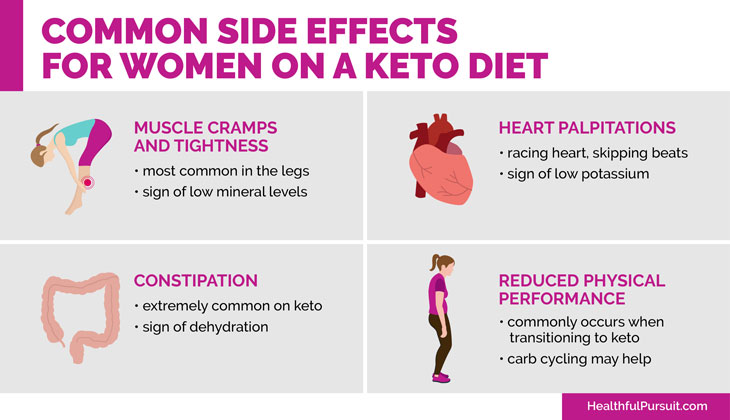
Common Side Effects For Women on a Keto Diet
Below are some of the most common side effects that women experience when starting on a ketogenic diet:
- Cramps and tightness, especially in the legs, are pretty common when starting a keto diet. They can be a telltale sign of low mineral levels (especially magnesium) in the body. Drinking lots of water, and eating salt on your food can help with this issue, but if you’re experiencing cramps despite staying hydrated and consuming salt, taking a magnesium supplement can help.
- Heart palpitations, like cramps, can be a sign of low levels of certain minerals, in this case, potassium. Again, drinking plenty of water and eating salt can help, but persistent palpitations can be treated with a potassium supplement.
- Constipation is extremely common for women to experience on a keto diet. This symptom is often caused by dehydration, because the keto diet is diuretic. If you’re experiencing constipation, be sure to drink extra water. It’s also important to consume plenty of fiber, found in vegetables. Remember that fiber is subtracted from total carbs when calculating net carbs.
- Reduced physical performance can be caused by your body adjusting to burning fat rather than carbohydrates. Strength and endurance levels should return to normal within a few weeks as your body adjusts. If poor physical performance remains a problem for you, you may benefit from increasing your clean carb intake right before a workout, or you can try cycling carbs (i.e. eating more carbs on heavy workout days). Be sure to stick to the most healthy carbs, like sweet potatoes or fruit.
Starting keto, and developing a protocol that works well for your body, starts when you begin to understand how keto works, and then use a template to help you discover how it works for your body. The Keto Beginning does just this, all packaged up in an easy to follow 30-day guide.
Avoid common keto mistakes with your 30-day guide, today.
Mistakes Women Make on Keto That Lead to Side Effects
If you’re experiencing some side effects when starting keto, they are most likely caused by one of these common mistakes. Here are some mistakes that many women make on a keto diet, and what you can do to reverse them:
- Not Getting Enough Electrolytes. Typical American diets are plenty high in sodium, mostly from the processed foods that are so prevalent in our diets. Many women find that when they start a keto diet, their salt intake is cut dramatically. While a low salt level may not sound harmful at first, it can result in a few problems. A diet extremely low in sodium and other salts can lead to fatigue and cravings, so it’s important to make sure your sodium level is sufficient. In addition, your body tends to excrete more potassium (and sodium) when you’re on a ketogenic diet, especially when you’re active, because you sweat it out. Replenish your potassium levels by loading up on healthy foods that are high in potassium like spinach and avocados. It’s the same case for magnesium as well. Many people are deficient in magnesium to begin with (most likely because of depleted magnesium levels in soil), so getting enough is essential. Magnesium helps our bodies to regulate both sleep and mood, and helps us to maintain general well being. A great way to get all the minerals listed above in abundance is to drink bone broth regularly. It’s high in magnesium, sodium, and potassium, and is great to replenish your body’s stores.
- Not Eating Enough Leafy Greens. Greens are absolutely some of the healthiest foods you can eat. But since a keto diet is extremely low in carbs, and vegetables tend to be high in carbs, some people aim to avoid all vegetables completely. This is a mistake. In fact, it’s important to consume as many vegetables as you can while still staying within your carb limits. While some vegetables (think root vegetables like onions, carrots, and potatoes) do tend to be very high in carbs, don’t cut all veggies out completely. Spinach, kale, collards, broccoli florets, and similar vegetables should be stars in your diet. They are relatively low in carbs, and are packed with many important nutrients that your body needs. Salads, smoothies, and stir-fried vegetables are quick and easy ways to get more of these key nutrients into your body daily without adding in too many carbs. And since vegetables are high in fiber, you need to remember to count only net carbs (total carb grams minus grams of fiber).
- Not Exercising Enough (Or At All). Exercise is essential to maintaining both a healthy body and mind. Exercise has tons of great benefits that are impossible to ignore, and has an important place in every diet and lifestyle. Exercise drains your glycogen stores. This is how glucose is stored in the body. In short, exercising will get your body into ketosis faster. This doesn’t mean you have to start an intensive workout routine when you start on a keto diet, though. You can do lots of simple exercises that don’t require special equipment or training. Walking every day is a great place to start, and only needs a few minutes of your time. It’s something many people can fit into a busy day. In addition, try adding in a few body weight exercises, like pushups, sit ups, and squats as part of your morning routine.
- Not Eating Enough. When you’re eating a diet that’s full of healthy and satiating fats, you’ll naturally want to eat less, and will experience fewer cravings. While this can be great for weight loss, it’s essential to make sure you’re getting enough calories to maintain a healthy body. No matter what diet you’re on, if you don’t eat enough calories, your body won’t have the fuel it needs to function properly. Instead of achieving weight loss goals, or gaining muscle mass, your body clings on to every calorie, just fighting to survive. You’ll run into many health problems and imbalances, and just generally not feel well. You also may end up experiencing cravings, and find it hard to resist binging on foods, as your body begs you to give it what it needs. Remedy this by keeping track of how many calories you’re consuming, and get a good idea of how many calories your body needs to be healthy. If you find that you’re not eating enough, try adding in a few clean carbs.
- Eating Too Few Carbs. Yes, the ketogenic diet is, by nature, a very low carb diet. Despite this, if you’re not getting enough carbs, your body might not be getting what it needs for you to be healthy. The amount of carbs you actually need depends on your hormone status, which we’ll discuss in another post. Sometimes, you may need to cycle carbs to get to a healthy level. Stick to fruits and higher carb veggies.
- Forcing Your Body To Fast. Fasting can be a great tool to help jumpstart weight loss on a keto diet, but it doesn’t always work for everyone. Fasting should be natural – if you aren’t hungry, don’t force yourself to eat. But if you are hungry, it’s important to listen to your body and give it what it needs. Don’t fast just for the sake of fasting. If you feel hungry, you need to eat!
In addition, check out this video I did a bit about about the 5 steps to take for keto flu.
What Is the Keto Flu and Why Is It a Problem for So Many Women?
The keto flu is a collection of symptoms that some people experience when starting a keto diet. You may feel weak, tired, fatigued, moody, or even a little nauseous. This is pretty common, and tends to go away after a few days. There are two reasons why people usually experience the keto flu:
- The ketogenic diet is a diuretic. This means that you’ll urinate more, which can lead to a loss of electrolytes and water from your body. Dehydration can leave you feeling really poor, which is why it’s important to restore your electrolytes and water. You can add Himalayan rock salt to water, drink lemon water, or add your favorite electrolyte drink to water. This will replenish your depleted electrolyte levels, and make you feel a great deal better.
- Your body is transitioning. It can take a while for your body to adjust, as your body is equipped to process a higher intake of carbs and a lower intake of fat. It takes time for your body to create enzymes to be able utilize fat fully. In the period while your body adjusts, your brain may run low on energy, which means you may feel groggy, tired, fatigued, or even have a headache. If this creates a huge problem for you, you can up your carb intake gradually until you feel better.
After you work to increase your water intake and replace your electrolytes, you should feel relief from most of your keto flu symptoms. For most people, after starting a keto diet eating 20 to 30 grams of net carbs a day, your body will adjust in four to five days. Eventually, you should work to cut your net carbs to fewer than 15 grams a day to ensure that you’re on your way to achieving ketosis within about a week. If you are experiencing keto flu symptoms severely, or for more than a week or two after you start, double check your electrolyte intake and adjust accordingly.
While keto flu tends to last less than a week or two, you can do a few things to minimize its duration, and just generally make you feel better faster:
- Drink more water (this is always important)
- Take some medium chain triglyceride (MCT) oil or exogenous ketones
- Add in a bit more healthy fat and protein to your diet
- Consider adding a bit of extra carbs. Clean carbs like sweet potatoes or fruit can be a great addition to your diet, and can help ease the transition on your body (I refer to this as “carb up”)
If you’re avid about exercise, and hit the gym regularly, you may notice some lost strength and endurance. This is common, and nothing to worry about, as a temporary decrease in physical performance is normal. Once your body fully adapts to your new diet, it will be able to fully utilize fat instead of carbs as its primary source of energy.
The initial transition period is often referred to as the fat-adaptation or keto adaptation period. Once this is over, you’ll begin to see the true benefits of the keto diet. Many women find they gain a lot of mental and physical energy – much more than they had on a regular diet. They don’t experience typical energy crashes in the afternoons and they often feel just as refreshed on a bit less sleep. Because of the high fat intake in the keto diet, many people just feel less hungry in general and tend to experience fewer cravings, and eat less as a result. This makes weight loss goals easier to achieve.
If you’re just starting out on a keto diet, you may feel a little apprehensive about the rumored side effects, but as long as you follow the instructions above, and watch out for the common pitfalls that many women experience, you’ll get over the keto flu in no time, and experience little or no side effects. Remember to drink enough water, give your body time to adapt, and eat plenty of the right foods, and you’ll reap the benefits of a keto diet.
Loved This Keto Content? Share on Pinterest!
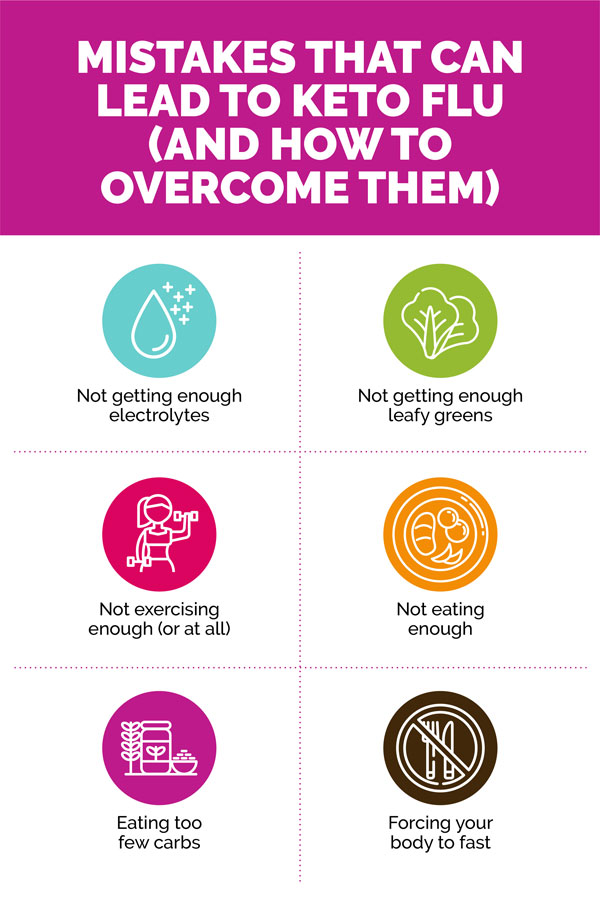
This entry was tagged: carb up, dairy-free keto, eating high-fat, eating keto, eating low-carb, fat-adapted, health, high fat, holistic nutrition, how eat keto, keto, keto basics, keto diet, keto for women, keto life, ketogenic, ketogenic diet, ketogenic for women, ketosis, low-carb, what is keto
Hi! I'm Leanne (RHN FBCS)
a Functional Medicine Practitioner, host of the Healthful Pursuit Podcast, and best-selling author of The Keto Diet & Keto for Women. I want to live in a world where every woman has access to knowledge to better her health.
